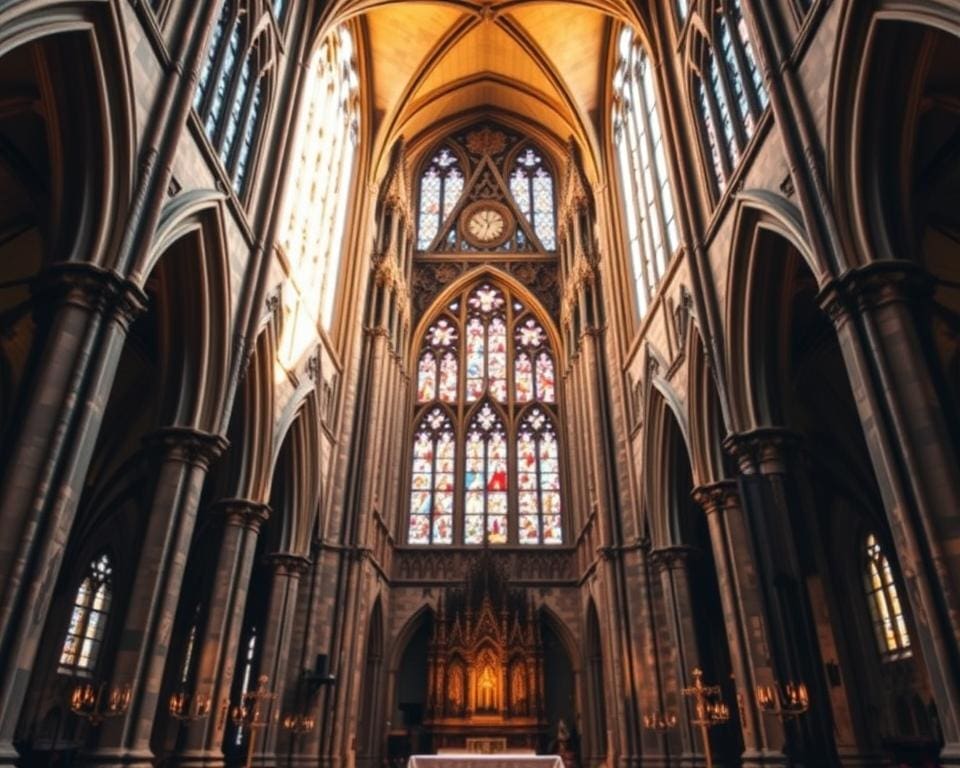The transformation of historic churches into residential properties is not merely a renovation; it is a celebration of architecture and history. With a growing interest in church restoration and conversion, many are drawn to these unique spaces that offer character and charm unlike any conventional home. As the demand for affordable housing rises in the United Kingdom, the allure of converting old churches into homes in England becomes ever more compelling, allowing modern living to intertwine with the rich tapestry of the past.
This burgeoning trend reflects a desire to preserve historic church renovation, turning these revered buildings into personal sanctuaries while maintaining their original beauty. By harmonising contemporary needs with the enduring spirit of heritage, individuals can create truly special living environments that resonate with stories of yesteryear, while also addressing today’s housing challenges.
Understanding the Appeal of Church Conversions
Churches possess an alluring charm that captures the imagination of many. Their conversion into homes presents an opportunity to embrace and celebrate their rich history while creating beautiful living spaces. This section explores how the unique architectural features of these historic structures and their historical significance contribute to their appeal.
Unique Architectural Features
The striking architecture of churches plays a crucial role in their desirability as residential properties. Features such as:
- Towering steeples that reach for the sky
- Intricately designed stained glass windows
- Exquisite woodwork that tells a story
- Spacious interiors with high ceilings
These elements offer a stunning backdrop for the historic church renovation process. Homeowners have the chance to enhance these architectural gems through thoughtful design, achieving a synthesis of functionality and aesthetic appeal. This heritage building transformation engages creativity, allowing for personal expression while respecting the integrity of the original structure.
Historical Significance
Beyond their architectural beauty, churches serve as vessels of local cultural narratives and history. Their walls resonate with the stories of generations, often reflecting the community’s past. Transforming these heritage buildings into homes fosters a connection between residents and their surroundings. This historical significance enriches everyday life, reminding inhabitants of the traditions and events that shaped their locales. Embracing this history makes the process of conversion not just a renovation but a homage to the legacy these structures carry.

The Church Conversion Process
Embarking on the church conversion process requires careful consideration and strategic planning. The initial steps involve assessing the church’s structural integrity and determining the feasibility of transforming it into a residential space. Engaging professionals becomes crucial at this stage to navigate the complexities of such a project. Skilled architects and planners can provide essential insights and guidance to ensure a successful conversion.
Initial Assessment and Feasibility Study
Conducting an initial assessment is vital in understanding the potential challenges and benefits of the church conversion process. This assessment includes evaluating the building’s current condition, historical significance, and unique architectural features. A comprehensive feasibility study should follow, analysing the costs involved, potential design options, and any limitations posed by local planning regulations.
Engaging Professionals for Expert Guidance
Involving professionals early on streamlines the church conversion process. Architects experienced in religious building conversions can offer creative solutions while ensuring compliance with planning permission for church conversions. Collaborating with heritage specialists allows homeowners to preserve essential features of the original structure, blending modern design with historical integrity. Their expertise significantly enhances the likelihood of a successful and harmonious transformation.
Planning Permission for Church Conversions
Embarking on a church conversion project requires careful navigation through various regulations and compliance measures. Acquiring planning permission for church conversions stands as a crucial first step. Understanding local regulations is essential in ensuring that the proposed transformations align with community standards and preservation requirements. Being aware of potential challenges, such as listed building status or conservation area designations, can significantly impact the success of your project.
Understanding Local Regulations
Local regulations vary by council and can influence what changes are permissible. Engaging with local guidelines is fundamental. A number of factors may be taken into account, including:
- Architectural integrity of the building
- Impact on surrounding areas
- Community feedback during the consultation process
Staying informed about these regulations supports a more streamlined application process and helps mitigate any potential setbacks.
Working with Planning Authorities
Successful church conversions depend greatly on effective collaboration with planning authorities. Preparing comprehensive proposals is vital; these should clearly outline your intentions and demonstrate an understanding of local regulations. Addressing community concerns with transparency can foster trust and support. Consider the following best practices:
- Engage early with local authorities
- Provide detailed plans and visual aids
- Incorporate community feedback into your design
By focusing on these practices, applicants can enhance their chances of receiving the necessary planning permissions required for transforming a cherished historical space into a modern home.
Costs Involved in Converting Churches into Homes
Understanding the costs involved in converting churches into homes is essential for anyone considering this unique transformation. This journey not only breathes new life into a historical structure but also requires careful financial planning to ensure a successful outcome.
Budgeting for Restoration and Renovation
Budgeting for restoration is a critical step in the conversion process. It is vital to account for both expected and unforeseen expenses. Common costs include structural repairs, upgrades to plumbing and electrical systems, and compliance with modern building regulations. Conducting a thorough assessment early on can help you anticipate the main expenses involved. Create a detailed budget that incorporates all potential costs to maintain financial control throughout the project.
Financial Considerations and Incentives
Financial considerations and incentives can significantly affect the overall expenses of converting a church into a home. Various grants and tax incentives dedicated to heritage conservation may be available, offering much-needed relief. Researching local and national programmes can uncover opportunities to reduce your financial burden. These incentives play a crucial role in making your dream of living in a converted church more attainable.
Listed Building Conversion Guidelines
Converting a church into a home offers a unique challenge and opportunity. Following the listed building conversion guidelines is essential for ensuring that these treasured spaces are treated with the care they deserve. Balancing modern living requirements with the need for preserving historic features allows homeowners to create beautiful residences while respecting the architectural significance of their properties.
Preserving Historic Features
When embarking on this conversion journey, maintaining the integrity of the building’s historical aspects should be a top priority. Key elements such as stained glass windows, ornate woodwork, and stone carvings should be kept intact or restored to their original conditions. Homeowners must conduct thorough research to understand the history and significance of the features involved, ensuring they remain a vital part of the building’s identity.
Complying with National and Local Standards
In the UK, converting a listed building means adhering to strict regulations. Complying with national and local standards ensures that renovations meet the requirements set forth by heritage organisations and local councils. It is essential to consult with experienced professionals who understand the legal framework. Obtaining the necessary permissions is crucial to avoid delays and potential issues during the renovation process.
Adaptive Reuse of Churches: Best Practices
The adaptive reuse of churches offers unique opportunities for creative home design while honouring historical significance. By implementing innovative design approaches, developers can transform these majestic structures into functional living spaces that cater to contemporary lifestyles. It is crucial to maintain the charm and character of the original architecture when undertaking such projects.
Innovative Design Approaches
Innovative design approaches in the adaptive reuse of churches often highlight their captivating architectural elements. Employing open floor plans can provide spacious interiors, allowing natural light to flood the area. Integrating modern amenities is essential, yet should align with the church’s aesthetics. Key strategies include:
- Utilising large windows to preserve the building’s grandeur while enhancing energy efficiency.
- Incorporating flexible room layouts that adapt to various usage needs.
- Emphasising original materials, such as timber beams and stone walls, to create a cohesive design.
Balancing Modern Needs with Heritage Preservation
Balancing modern needs with heritage preservation is a critical consideration in the transformation process. This involves respecting the building’s historical context while providing necessary updates. Some practical tips to achieve this balance include:
- Engaging conservation specialists to guide preservation efforts without compromising the structure.
- Implementing sustainable practices that resonate with contemporary environmental standards.
- Incorporating smart home technologies discreetly, preserving the church’s aesthetic integrity.
Through these practices, the adaptive reuse of churches can result in inspirational living environments that respect the legacy of the building while fulfilling the demands of modern life.
Transforming Your Church into a Residential Property
Converting a church to residential property presents a unique opportunity to create a home filled with character and charm. This process involves thoughtful planning and creativity, particularly when it comes to designing functional living spaces that respect the building’s historical significance while catering to modern lifestyles.
Designing Functional Living Spaces
When undertaking this transformation, focus on designing functional living spaces that blend seamlessly with the church’s architecture. Consider the layout, ensuring that areas such as kitchens, living rooms, and bathrooms are practical yet inviting. Use the natural light provided by the church’s stained glass and high ceilings to create bright, airy environments. Open-plan designs can enhance connectivity, while dividing spaces with partitions or furnishings maintains definition.
Flexibility is crucial, as these spaces may need to serve various purposes. Incorporate multi-functional furniture to maximise the use of available space. The end goal is to create a home that is both comfortable and functional, echoing the original purpose of the church while accommodating today’s needs.
Incorporating Sustainable Practices
Incorporating sustainable practices during the conversion can lead to an energy-efficient home that respects the environment. Choose eco-friendly materials that not only look contemporary but are also sustainable. Insulation that aligns with modern standards, paired with energy-efficient heating and lighting systems, will contribute to a reduced carbon footprint.
Consider installing solar panels discreetly on the roof to harness renewable energy without detracting from the church’s aesthetic appeal. Rainwater harvesting systems can be integrated into the property, promoting sustainability further and ensuring that modern comforts blend harmoniously with this historic structure. By prioritising sustainability, homeowners can create a modern living environment within a historic context, enhancing the charm of the converted church.
Success Stories of Church Restorations
Across England, many remarkable success stories of church restorations exemplify the extraordinary potential of heritage building transformation. One inspiring example is the conversion of St. Mary’s Church in Nottingham, which has been transformed into a stylish residential complex while meticulously preserving its iconic stained glass and vaulted ceilings. This project not only revitalised a significant historical site but also contributed positively to the local community by providing much-needed housing.
Another notable case is the former St. Luke’s Church in Birmingham, now a unique arts centre. This church restoration and conversion demonstrates the versatility of these heritage buildings. By embracing modern design elements alongside their history, the transformation has created a vibrant space for artistic expression and community engagement, showcasing how adaptive reuse can breathe new life into once-neglected structures.
These success stories of church restorations act as a beacon for future projects, encouraging others to envision what is possible through creativity and dedication. By taking inspiration from successful transformations like those of St. Mary’s and St. Luke’s, individuals and developers alike can pursue their ambitions in preserving and repurposing these cherished landmarks, ensuring they thrive for generations to come.









